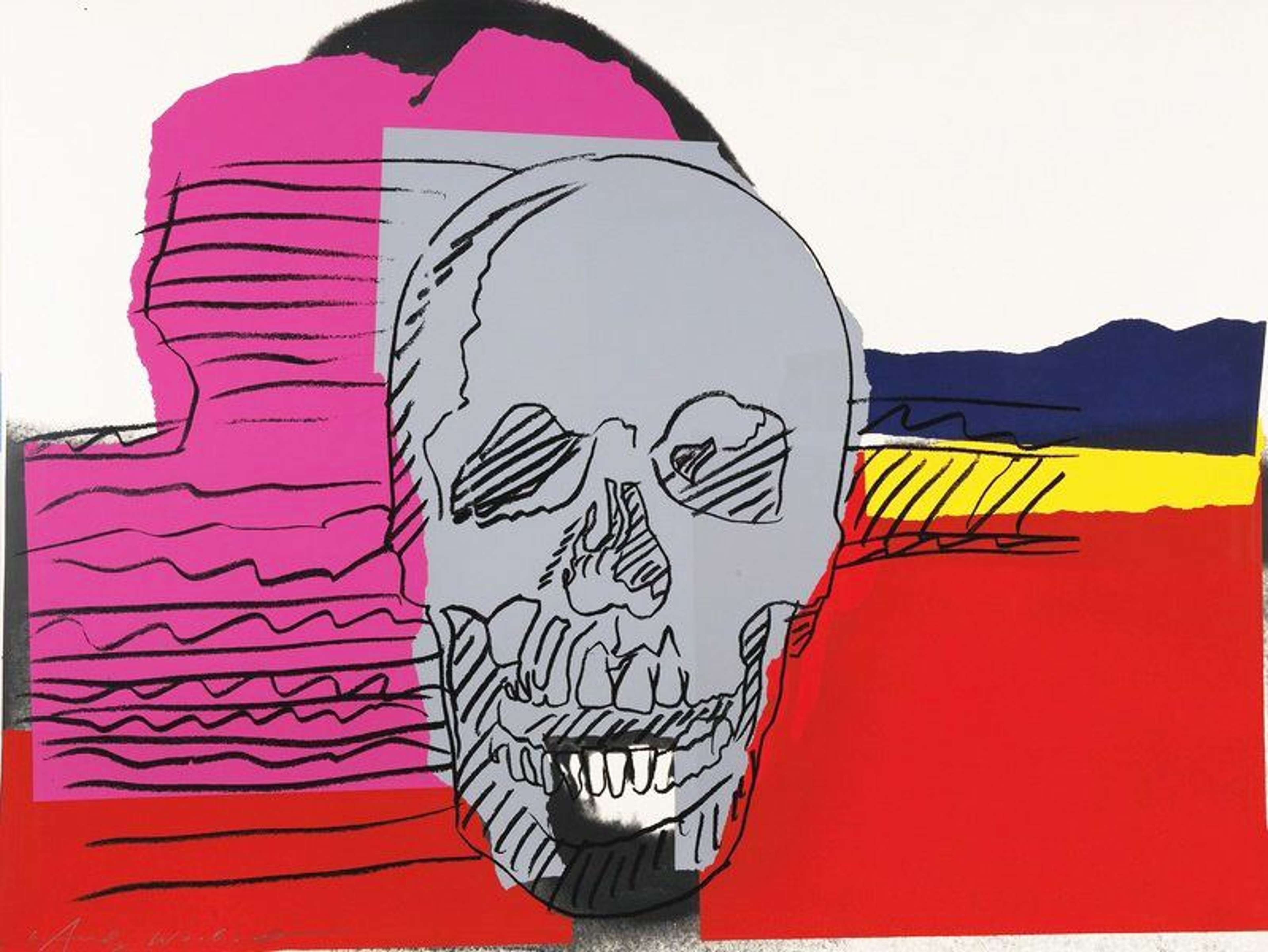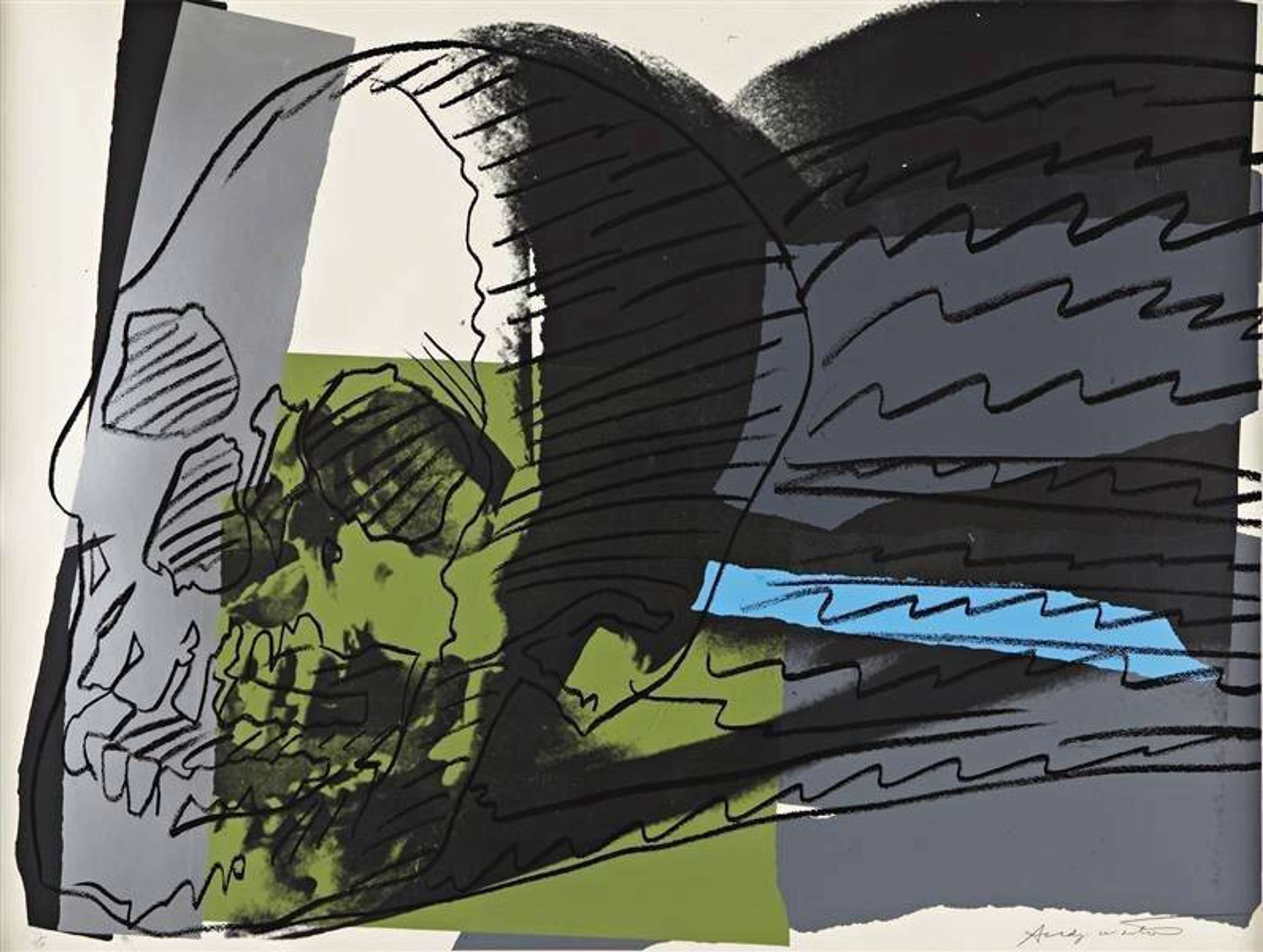 Skull (F. & S. II.157) © Andy Warhol, 1976
Skull (F. & S. II.157) © Andy Warhol, 1976
Interested in buying or selling
Andy Warhol?

Andy Warhol
487 works
In his Skulls series Andy Warhol takes his fascination with death, particularly the deaths of celebrities, a step further, creating a full still life series based on images of a skull on a flat surface, in the tradition of momento mori paintings.
Skulls were a very important motif as part of Warhol’s oeuvre.
 Skull (F. & S. II.159) © Andy Warhol, 1976
Skull (F. & S. II.159) © Andy Warhol, 1976Warhol represented skulls in collages, prints, paintings, drawings, and even in self-portraits. The most recognisable images from this body of work are his still life prints.
These still life prints are based on photographs.
 Skull (F. & S. II.160) © Andy Warhol, 1976
Skull (F. & S. II.160) © Andy Warhol, 1976These screen prints are based on photographs taken by Warhol’s assistant Robbie Cutrone. The photographs show a skull resting on a flat surface, taken from a slightly raised perspective.
This set of prints calls into question the concept of the icon.
 Cantaloupes II (F. & S. II.198) © Andy Warhol, 1979
Cantaloupes II (F. & S. II.198) © Andy Warhol, 1979His work also calls into question the concept of the icon, most frequently explored in his representation of celebrities such as Marilyn Monroe, Muhammad Ali, and Elizabeth Taylor. However, the concept of the ‘iconic’ is explored on a more symbolic scale in his decision to depict the icon of the skull in an image which illustrates the multiplication of death.
Warhol is interested in the ephemeral nature of human life.
 Skull (F. & S. II.157) by Andy Warhol, 1976
Skull (F. & S. II.157) by Andy Warhol, 1976Warhol’s Skulls series has been widely interpreted as an expression of the artist’s desire to evoke the ephemerality of the human condition.
This series differs in style from Warhol’s earlier works.
 Skull (F. & S. II.158) © Andy Warhol, 1976
Skull (F. & S. II.158) © Andy Warhol, 1976The artist also employs a more painterly aesthetic than in his earlier screen prints with brushstrokes to create surfaces of poetic movement, as exemplified in the expressive marks of Skull 157.
The Skulls are in direct contrast to Warhols images of celebrities.
 Skull (F. & S. II.160) © Andy Warhol, 1976
Skull (F. & S. II.160) © Andy Warhol, 1976In these earlier portraits, Warhol encapsulated the identity of well-known individuals through the characteristics that make them recognisable and pre-eminent in popular culture. The Skull series subverts this by presenting a subject devoid of any individuality, its repetition both magnifying and desensitising the ubiquitous human condition of mortality.
These prints could be related to Warhol’s near-death experience.
 Gems (F. & S. II.89) © Andy Warhol, 1978
Gems (F. & S. II.89) © Andy Warhol, 1978Some art historians have also linked this motif to the artist’s near-fatal shooting in 1968, suggesting that his Skulls series is a reflection upon this experience and his awareness of the inevitability of death.
Warhol wrote about death.
 Gems (F. & S. II.86) © Andy Warhol, 1978
Gems (F. & S. II.86) © Andy Warhol, 1978Nonetheless, in his book The Philosophy of Andy Warhol, Warhol wrote about death stating “I don’t believe in it because you’re not around to know that it’s happened. I can’t say anything about it because I’m not prepared for it.”
This series represents Warhol’s creativity when it came to the still life genre.
 Gems (F. & S. II.87) © Andy Warhol, 1978
Gems (F. & S. II.87) © Andy Warhol, 1978As with his iconic Flowers series (1974), Warhol takes a playful approach to the art historical genre of still life painting, the subject of the skull making specific reference to ‘vanitas’ still lifes.
Warhol’s assistant Cutrone spoke of the the importance of these prints.
 Gems (F. & S. II.88) © Andy Warhol, 1978
Gems (F. & S. II.88) © Andy Warhol, 1978Warhol’s assistant Cutrone once commented that to paint a skull ‘is to paint the portrait of everybody in the world.’ Through his obsessive repetition of the subject throughout his body of work, Warhol both desensitises and amplifies the permeating human condition of mortality.